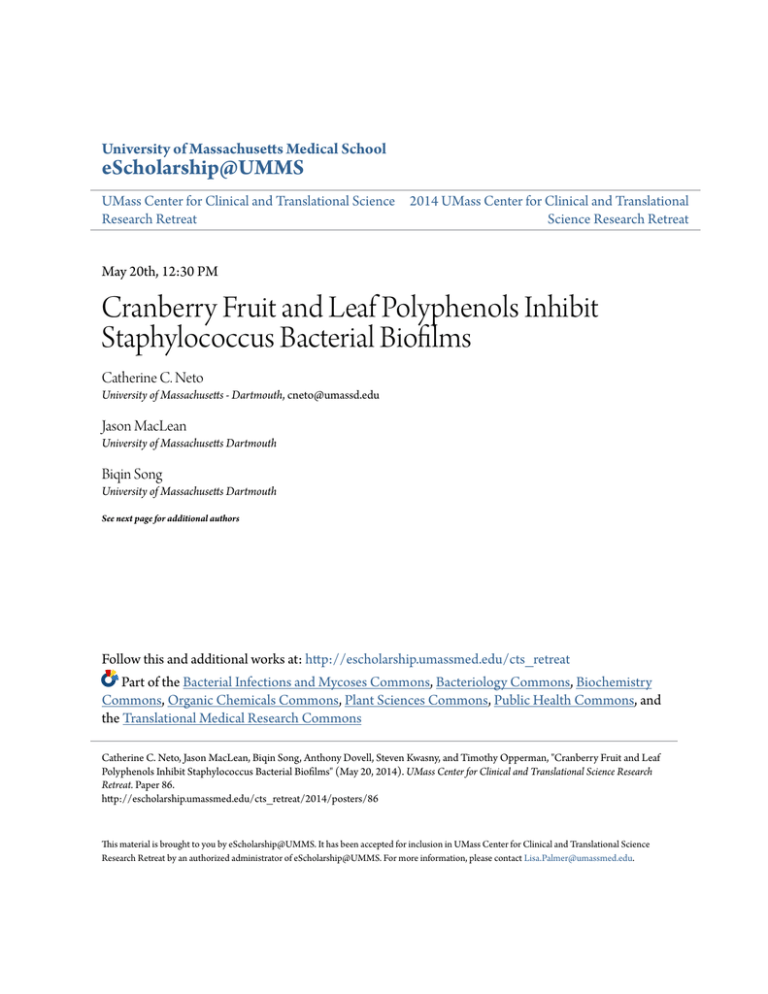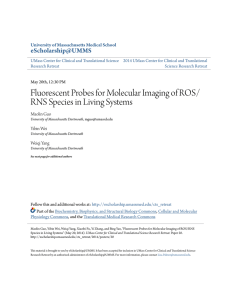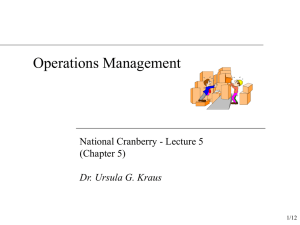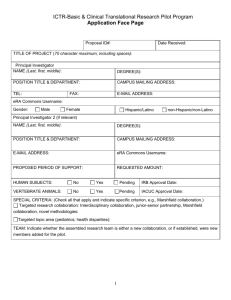- eScholarship@UMMS - University of Massachusetts
advertisement

University of Massachusetts Medical School eScholarship@UMMS UMass Center for Clinical and Translational Science 2014 UMass Center for Clinical and Translational Research Retreat Science Research Retreat May 20th, 12:30 PM Cranberry Fruit and Leaf Polyphenols Inhibit Staphylococcus Bacterial Biofilms Catherine C. Neto University of Massachusetts - Dartmouth, cneto@umassd.edu Jason MacLean University of Massachusetts Dartmouth Biqin Song University of Massachusetts Dartmouth See next page for additional authors Follow this and additional works at: http://escholarship.umassmed.edu/cts_retreat Part of the Bacterial Infections and Mycoses Commons, Bacteriology Commons, Biochemistry Commons, Organic Chemicals Commons, Plant Sciences Commons, Public Health Commons, and the Translational Medical Research Commons Catherine C. Neto, Jason MacLean, Biqin Song, Anthony Dovell, Steven Kwasny, and Timothy Opperman, "Cranberry Fruit and Leaf Polyphenols Inhibit Staphylococcus Bacterial Biofilms" (May 20, 2014). UMass Center for Clinical and Translational Science Research Retreat. Paper 86. http://escholarship.umassmed.edu/cts_retreat/2014/posters/86 This material is brought to you by eScholarship@UMMS. It has been accepted for inclusion in UMass Center for Clinical and Translational Science Research Retreat by an authorized administrator of eScholarship@UMMS. For more information, please contact Lisa.Palmer@umassmed.edu. Presenter Information Catherine C. Neto, Jason MacLean, Biqin Song, Anthony Dovell, Steven Kwasny, and Timothy Opperman Comments Abstract of poster presented at the 2014 UMass Center for Clinical and Translational Science Research Retreat, held on May 20, 2014 at the University of Massachusetts Medical School, Worcester, Mass. Creative Commons License This work is licensed under a Creative Commons Attribution-Noncommercial-Share Alike 3.0 License. This is available at eScholarship@UMMS: http://escholarship.umassmed.edu/cts_retreat/2014/posters/86 Cranberry fruit and leaf polyphenols inhibit Staphylococcus bacterial biofilms Catherine Neto1, Jason MacLean1, Biqin Song1, Anthony Dovell1, Steven Kwasny2, Timothy Opperman2 1 UMass Cranberry Health Research Center and Department of Chemistry and Biochemistry, UMass-Dartmouth, North Dartmouth, MA 2 Microbiotix, Inc., Worcester, MA 01605 Contact: Catherine Neto (cneto@umassd.edu) Cranberry (Vaccinium macrocarpon) is known for urinary tract health benefits associated with reducing the adhesion of E. coli bacteria. This property has been linked to cranberry polyphenols known as proanthocyanidins. Staphylococcus bacteria are a growing public health concern due to development of resistant strains. Identification of agents that inhibit biofilm formation by these bacteria may provide a new route to reduce infection in clinical settings. Fruit and leaves of North American cranberry (Vaccinium macrocarpon) and cranberry juice were fractionated and screened for their ability to prevent biofilm formation by several strains of S. aureus and S. epidermidis bacteria. MALDI-TOF MS analysis of the most bioactive fractions identified the major constituents as proanthocyanidin oligomers (PACs) with A-type linkages, ranging in size from 2-12 degrees of polymerization. Further characterization by NMR is underway. The polyphenol-rich fractions from cranberry leaf, fruit and juice inhibited biofilm formation by strains of S. aureus and S. epidermidis, with MBIC as low as 3.1 μg/mL, and without significant bacteriocidal activity. Thus, compounds from cranberry fruit, plant material and juice may be useful in reducing Staphylococcus biofilms without promoting resistance.



